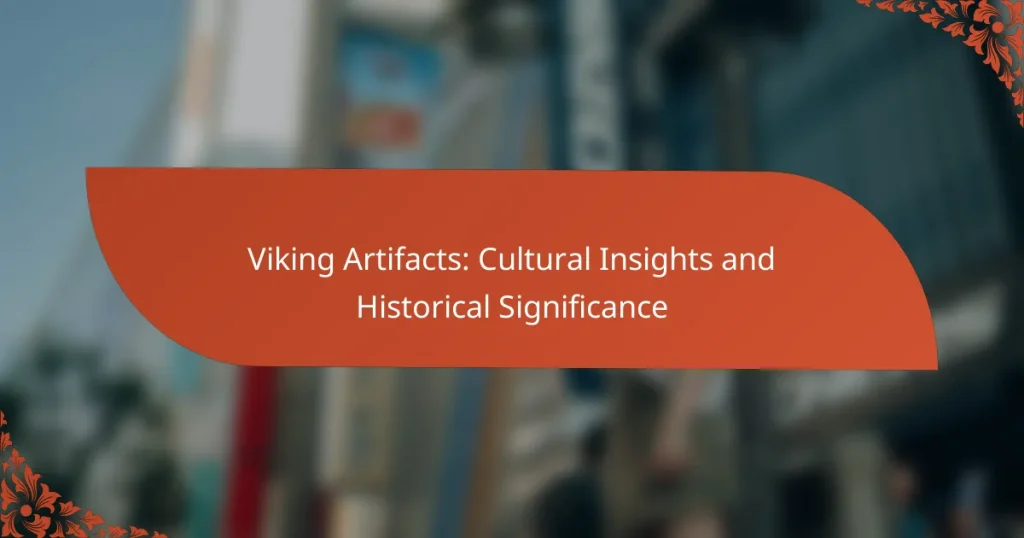
Viking Artifacts: Cultural Insights and Historical Significance
Viking artifacts serve as crucial links to understanding the culture and daily life of the…
Viking heritage offers a captivating glimpse into a remarkable era that shaped European history from the late 8th to the early 11th century. Through historical sites, museums, and reenactments in Scandinavia, visitors can immerse themselves in the rich culture, social structures, and artistic achievements of the Vikings. This exploration reveals the profound impact of their explorations, raids, and settlements on trade and cultural exchanges across the continent.

Viking artifacts serve as crucial links to understanding the culture and daily life of the Norse people during the Viking Age. These items, which include tools, jewelry, and everyday objects, offer valuable insights into their social structures, beliefs, and technological advancements, reflecting the rich tapestry of their civilization. What are the most significant Viking artifacts?…

Viking festivals in the UK play a crucial role in educational outreach by offering immersive experiences that captivate both students and communities. These events not only entertain but also deepen participants’ understanding of Viking history and culture through hands-on activities, workshops, and reenactments. How do Viking festivals enhance educational outreach in the UK? Viking festivals…
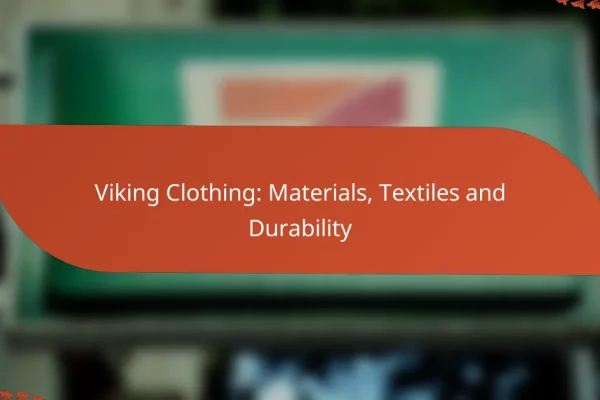
Viking clothing was crafted from natural materials such as wool, linen, leather, fur, and silk, each selected for its specific benefits in terms of warmth, breathability, and durability. The use of these textiles not only ensured comfort but also contributed to the impressive longevity of their garments, making them well-suited for the harsh Scandinavian climate….
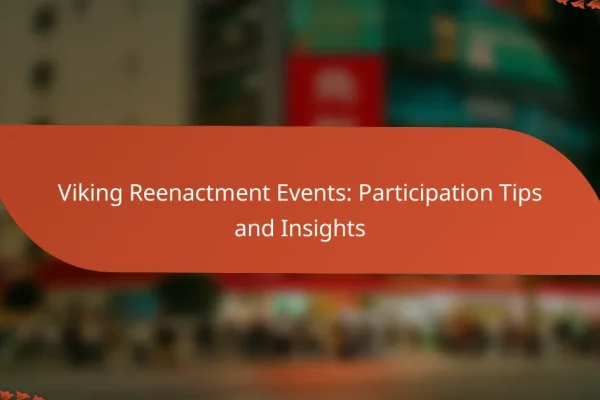
Participating in Viking reenactment events in the UK offers a unique opportunity to immerse yourself in the rich culture and history of the Vikings. To fully engage, it’s essential to join local groups, attend training sessions, and prepare authentic clothing, armor, and weapons. By following these steps, you can enhance your experience and contribute to…

Viking ships played a crucial role in Norse society, serving as vessels for trade, exploration, and warfare. Their innovative design not only facilitated efficient maritime transport but also transformed cultural exchanges across Scandinavia and beyond. With features that optimized speed and navigability, these ships were instrumental in the Vikings’ ability to launch swift military operations…

The Viking era was marked by a deep connection to the natural world, with foraging techniques that allowed them to gather a variety of wild ingredients. From wild garlic to sea buckthorn, these natural sources not only enriched their diets but also provided unique flavors and nutritional benefits. Understanding the visual characteristics and seasonal availability…
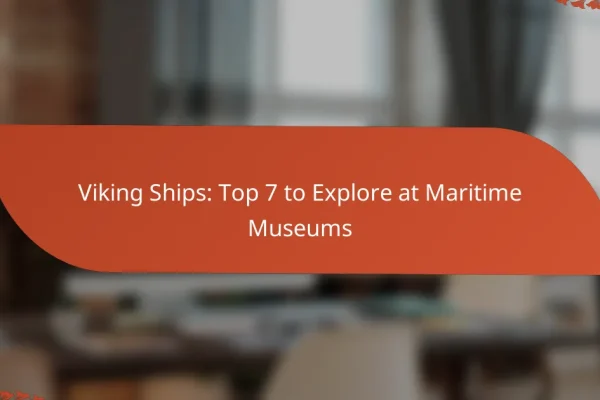
Scandinavia boasts a rich maritime heritage, with several museums dedicated to the exploration of remarkable Viking ships that highlight their historical significance and craftsmanship. Notable vessels like the Oseberg and Gokstad ships in Oslo, along with the Skuldelev ships in Roskilde, offer visitors a glimpse into the Viking era’s maritime culture and innovations. Planning your…
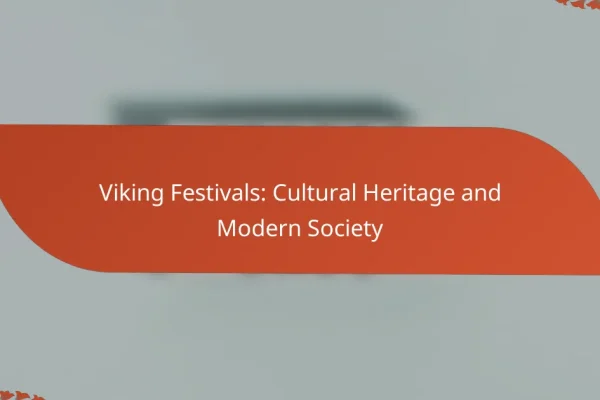
Viking festivals in Scandinavia offer a vibrant celebration of the rich cultural heritage from the Viking Age, featuring reenactments, traditional crafts, and immersive educational activities. These events attract both locals and tourists, allowing participants to engage with the history and values of the Norse people through music, storytelling, and authentic culinary experiences. What are the…
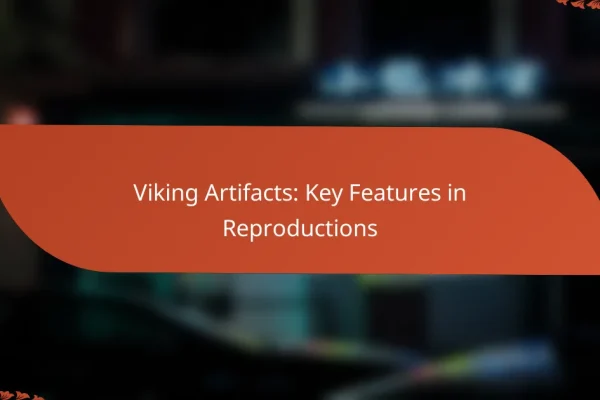
Viking artifact reproductions are characterized by their use of authentic materials, meticulous craftsmanship, and historical accuracy, reflecting the distinctive artistic motifs of the era. By focusing on these key features, these replicas provide valuable insights into Viking culture while allowing enthusiasts to engage with history safely and meaningfully. What are the key features of Viking…
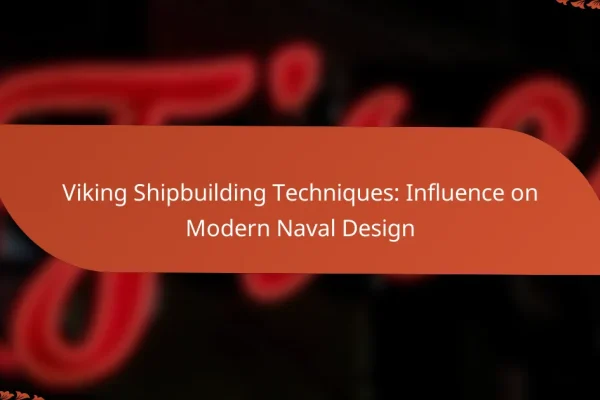
Viking shipbuilding techniques have left a lasting legacy on modern naval design, showcasing innovative hull shapes and construction methods that prioritize performance and stability. The ancient practices of clinker-building and the use of natural materials continue to inspire contemporary shipbuilding, emphasizing efficiency and adaptability in maritime engineering. How did Viking shipbuilding techniques influence modern naval…
You can experience Viking heritage in Scandinavia by visiting historical sites, exploring specialized museums, and participating in reenactments that bring this fascinating culture to life. Each country offers unique opportunities to engage with Viking history through immersive experiences.
Norway is home to numerous historical sites that showcase Viking heritage, including burial mounds, ancient stave churches, and reconstructed longhouses. Key locations such as the Gokstad and Oseberg burial sites provide insight into Viking shipbuilding and burial practices.
When visiting, consider guided tours that offer in-depth knowledge about the significance of these sites. Many locations also have visitor centers with exhibits that enhance your understanding of Viking life and culture.
Sweden features several Viking museums that provide a comprehensive look at this era. The Vasa Museum in Stockholm, for example, houses a well-preserved 17th-century ship and exhibits on maritime history, while the Swedish History Museum offers extensive Viking artifacts.
Plan your visit to coincide with special exhibitions or events, which often include workshops and lectures. These interactive experiences can deepen your appreciation of Viking craftsmanship and daily life.
Denmark hosts various reenactments that allow visitors to step into the shoes of Vikings. Events are often held at historical sites like the Ribe Viking Center, where you can watch battles, craft demonstrations, and traditional Viking games.
To make the most of your experience, check the event calendar ahead of time and consider participating in workshops that teach skills such as archery or blacksmithing. Engaging directly with these activities can provide a unique perspective on Viking culture.
Viking culture is characterized by its rich social structure, deep-rooted religious beliefs, and impressive artistic achievements. These aspects shaped their daily lives, community interactions, and legacy throughout history.
The Viking social structure was hierarchical, consisting of classes such as kings, jarls (nobles), karls (freemen), and thralls (slaves). Each class had distinct roles and responsibilities, influencing community dynamics and governance.
Communities were often organized around farms or settlements, where cooperation was essential for survival. Decisions were made collectively in assemblies known as "things," where free men could voice their opinions and settle disputes.
Viking religion was polytheistic, with a pantheon of gods including Odin, Thor, and Freyja. Their beliefs were deeply intertwined with nature and the cosmos, reflected in their myths and legends that explained natural phenomena and human experiences.
Rituals and sacrifices were common, aimed at gaining favor from the gods for successful voyages or bountiful harvests. The Vikings also believed in an afterlife, with Valhalla being a prominent concept for warriors who died bravely in battle.
The Vikings were skilled artisans, known for their intricate metalwork, wood carving, and textile production. Their art often featured motifs from their mythology, showcasing animals and interlacing patterns that conveyed cultural significance.
Craftsmanship was not only functional but also decorative, as seen in their longships, which were designed for both speed and beauty. The use of vibrant colors and detailed designs in everyday objects reflected their appreciation for aesthetics in daily life.
The Viking Age, spanning from the late 8th century to the early 11th century, is marked by significant events that shaped European history. Key occurrences include raids, explorations, and the establishment of settlements, which had lasting impacts on trade and cultural exchanges across the continent.
The Viking Age is generally considered to have begun around 793 AD with the raid on Lindisfarne, a monastery in England. This period lasted until approximately 1066 AD, culminating in the Battle of Stamford Bridge, which marked the end of Viking dominance in England. Key phases within this timeline include the early raids, the establishment of trade routes, and the eventual conversion to Christianity.
Vikings are renowned for their extensive raids across Europe, targeting monasteries, towns, and trade centers. Notable raids include the aforementioned attack on Lindisfarne and the siege of Paris in 845 AD. Additionally, Viking explorers reached as far as North America, with Leif Erikson credited for landing in present-day Newfoundland around 1000 AD.
Several influential leaders and explorers shaped Viking history, including Ragnar Lothbrok, a legendary figure known for his raids across France and England. Another significant figure is Harald Hardrada, who attempted to claim the English throne in 1066. Additionally, figures like Erik the Red and Leif Erikson are celebrated for their explorations and settlements in Greenland and North America, respectively.
Viking trade significantly influenced Europe by establishing extensive networks that facilitated the exchange of goods, culture, and ideas. These interactions helped shape the economies and societies of various regions, leading to increased wealth and cultural exchange.
The Vikings developed a vast network of trade routes that connected Scandinavia with Europe, Asia, and beyond. They navigated rivers and seas, using longships to travel from the Baltic Sea to the Mediterranean and even to the Middle East. Key routes included the rivers of Russia, which led to Constantinople, and the North Sea, linking them to England and France.
These routes not only allowed for the transport of goods but also facilitated cultural exchanges and the spread of technology. The establishment of these trade pathways laid the groundwork for future economic interactions in Europe.
Viking markets were bustling hubs of commerce where a variety of goods were exchanged. Key items included furs, amber, and slaves from the north, while they imported silver, spices, and textiles from the south and east. This exchange of goods enriched both Viking society and their trading partners.
Additionally, the Vikings traded in luxury items such as jewelry and weapons, which were highly sought after in various regions. The diversity of goods available in Viking markets reflected the extensive reach of their trade networks.
The impact of Viking trade on European economies was profound, contributing to the growth of towns and the emergence of a merchant class. As trade flourished, regions began to specialize in certain goods, leading to increased economic interdependence among European societies.
Moreover, the influx of wealth from Viking trade stimulated local economies, allowing for advancements in craftsmanship and infrastructure. This economic boost played a crucial role in the transition from feudalism to more market-oriented economies in the centuries that followed.
Modern interpretations of Viking heritage encompass a blend of historical appreciation, cultural revival, and creative expression. This includes celebrating Viking history through festivals, literature, and reenactments, which aim to connect contemporary society with the values and traditions of the Viking Age.
Viking festivals are held in various major cities, celebrating Norse culture through music, food, and traditional crafts. Events like the Jorvik Viking Festival in York, UK, and the Viking Festival in Lindsborg, Kansas, USA, attract thousands of visitors each year. These festivals often feature reenactments, workshops, and markets where attendees can experience Viking life firsthand.
Participants can enjoy activities such as sword fighting demonstrations, storytelling, and craft-making, providing a lively atmosphere that highlights the Viking legacy. Many festivals also include authentic Viking cuisine, allowing visitors to taste dishes inspired by historical recipes.
Viking-themed media and literature have surged in popularity, with numerous books, films, and television series exploring Norse mythology and Viking history. Popular shows like "Vikings" and "The Last Kingdom" have introduced audiences to the dramatic tales of Viking warriors and their adventures. These narratives often blend historical facts with fictional elements, creating engaging stories that resonate with modern viewers.
Literature, ranging from academic texts to novels, continues to explore Viking culture, providing insights into their beliefs, societal structures, and daily life. Authors like Neil Gaiman and Bernard Cornwell have contributed to this genre, making Viking tales accessible and entertaining for a broad audience.
Contemporary Viking reenactment groups play a vital role in preserving and promoting Viking heritage. These groups often participate in events and festivals, showcasing authentic clothing, weaponry, and combat techniques. Members typically engage in extensive research to accurately portray Viking life, from crafting period-appropriate items to practicing traditional skills.
Joining a reenactment group can offer individuals a hands-on experience of Viking culture, fostering a sense of community among enthusiasts. Many groups also focus on educational outreach, providing workshops and demonstrations to teach others about Viking history and its relevance today.